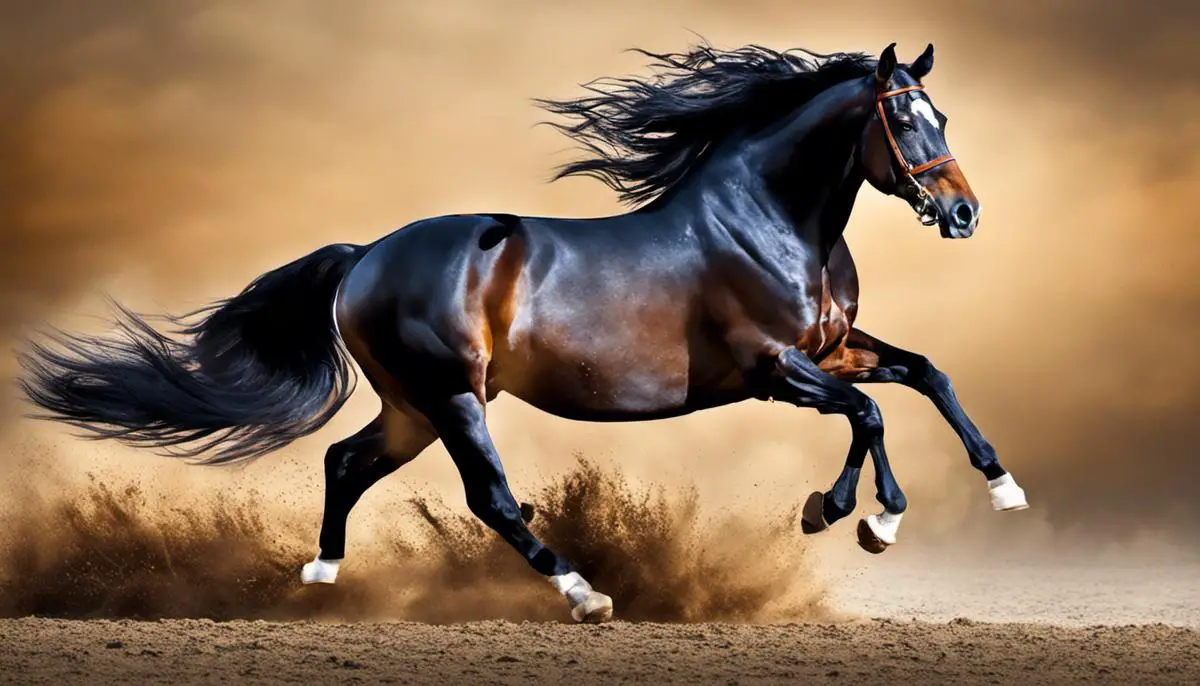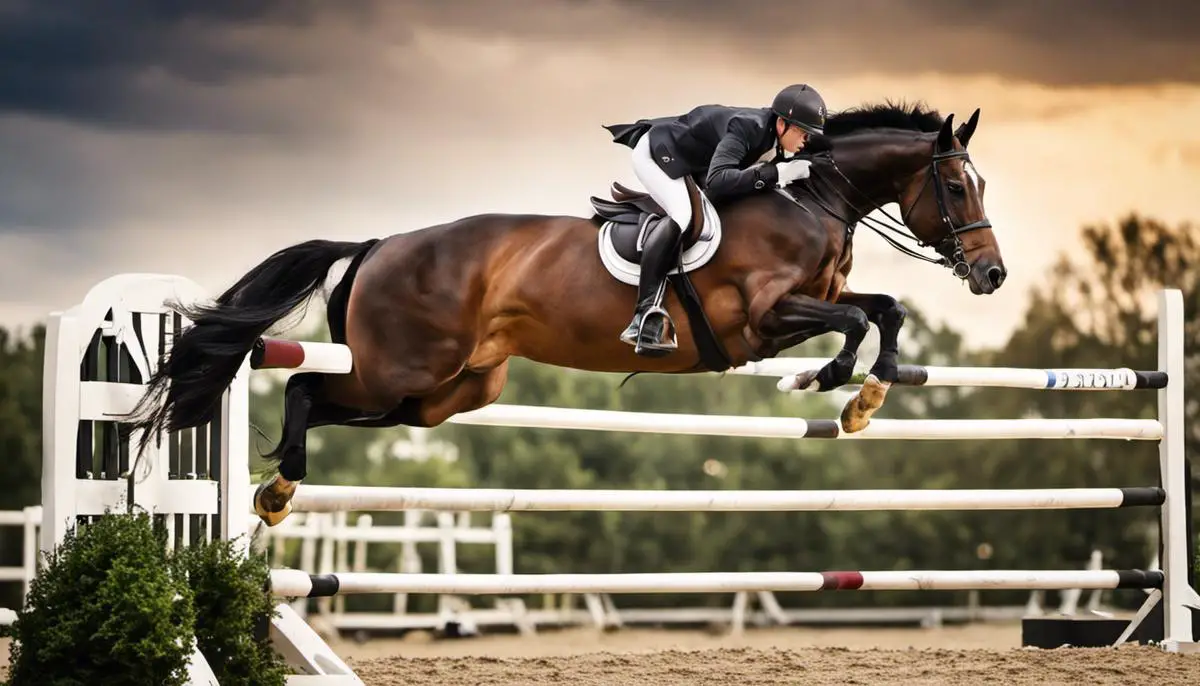Regarded as one of the oldest and most distinguished German warmblood breeds, the Holsteiner horse primarily stands out for its versatility and athleticism. Renowned for being fast learners with a calm demeanor, these elegant horses display strong physical characteristics that contribute to their adeptness in various equine disciplines. This essay offers an extensive exploration of the dynamic Holsteiner horses – delving into their breed characteristics, their historical journey from medieval war horses to contemporary sport horses, and their vibrant presence in the modern equestrian world.
Table of Contents (Horspedia)
Breed Characteristics of Holsteiner Horses
Holsteiner Horses: Physical Attributes and Build
Holsteiner horses are large, typically standing at between 16 and 17 hands high, with some males reaching up to 17.2 hands. Their weight usually falls within the range of 1,200 to 1,400 pounds. They have powerful, well-proportioned bodies, characterized by strong loins, deep chests, and broad, sloping shoulders. The head of the Holstein is desirable, with expressive eyes and a straight or slightly convex profile. The legs of these horses are long and strong, with the capability of carrying their large body sizes with agility and speed.
Remarkable about Holsteiner horses are their athletic abilities. They are known for their speed, mobility, and jumping prowess, making them desirable for equestrian sports such as show jumping, dressage, and eventing. Their back is notably short and strong, barely longer than their powerful hindquarter, contributing to the horse’s excellent jumping ability.
Color and Coat Characteristics of Holsteiner horses
The typical coat color of Holsteiner horses ranges from bay, chestnut, black, and gray. While these colors are the most commonly seen, it’s not uncommon to find Holsteiners with markings such as stars, strips, socks, and blazes. The coat is generally shiny and smooth, offering an admirable and attractive look.
Holsteiner Horse Temperament and Intelligence
Holsteiners boast a balanced and calm temperament. They are known for their reliability, courage, and intelligence. These horses display a great willingness to work and learn, making them easy to train. Their alertness and keen perception also contribute to their exceptional performance in competitive settings.
The intelligence of the Holsteiner horse becomes evident when dealing with complex commands or learning new tasks. This intelligence, combined with their calm and composed temperament, make them ideal for professional and amateur riders alike.
Physical Abilities: Speed, Agility, and Endurance
Holsteiners exhibit remarkable speed and agility. They are known for their swift movements and are capable of covering large spaces in a short amount of time. This is partly due to their powerful hindquarters and well-structured legs, which allow for fast and agile movements.
Their sturdiness and endurance also stand out in the Holsteiner breed. They have the capacity to work for extensive periods without easily tiring. This endurance stems from their historic use in farming, where they were required to work long hours in challenging environments. As a result, these horses developed the capacity to keep performing at high levels, even under pressure. This attribute plays a significant role in their popularity in the equitation world, particularly in long-distance racing and other endurance-related sports.
Why Holsteiner Horses are prized in the Equestrian World
Holsteiner horses possess a set of commendable traits that make them highly treasured in the equestrian world. These traits include their unparalleled power, speed, sense of intelligence, agility, and endurance. The versatility and adaptability characteristic of the Holsteiners make them perfect for a number of disciplines, but they are most commonly associated with show-jumping and dressage. Notably, Holsteiner horses shine in eventing, a competition which tests a horse’s proficiency in dressage, cross-country, and show-jumping events.

The Historical Origin of Holsteiner Horses
A Peek into the Holsteiner Horse’s Medieval Origins
Originating from Germany, the Holsteiner horse breed boasts a history that weaves back around 700 years, entrenched deep into the medieval era. During these times, the breed was majorly used for war purposes owing to its notably robust body structure that could readily bear the weight of hefty armor, and its agile yet durable endurance. The Holsteiner horse breed was carefully nurtured and enhanced by the monks of Uetersen until the 14th century, thereby ensuring the evolution of their unrivaled stamina and vitality that we see today.
The Evolution of the Holsteiner Horse in the Domestic Sphere
As the society shifted away from war-based economies, the function and development of Holsteiner horses evolved as well. They began to be revered for their strong work ethics and their elegant and dynamic abilities, which were beneficial for farming and harness work. Over centuries, intentional breeding refined the Holsteiner’s quality, creating a balance between athleticism, strength, and equine beauty. The Holstein region of Germany became increasingly important in refining the breed, earning a reputation for producing exceptionally quality horses.
The Influence of Thoroughbred Bloodlines in Enhancing the Holsteiner Breed
In the late 18th and early 19th century, the influence of thoroughbred bloodlines started to shape the breed further. English and Arabian stallions were introduced into Holsteiner breeding to enhance the breed’s speed, elegance, and jumping ability. The breeders were highly selective, ensuring that the original Holsteiner traits of power and hardiness weren’t compromised. This ensured the Holsteiner continued to exhibit their renowned strength and resilience, while demonstrating improved speed and agility.
Holsteiner Horses and the World Wars
During both World Wars, the Holsteiner breed played substantial roles. In World War I, they were utilized for their original purpose as war horses once again due to their durability and stamina. However, World War II left many European horse breeds, including the Holsteiner, on the brink of extinction. In fact, there were only about 1,000 Holsteiner mares left in the world by the end of World War II. But dedicated breeders began to restore the breed after the war, by crossbreeding them with the remaining stallions.
The Evolution of the Holsteiner: Transitioning from War Horse to Sport Horse
As the demand for horses in warfare and workforces took a backseat due to societal progression and technological advancements, the Holsteiner found a fresh arena to display its prowess: equestrian sports. These sports demanded horses with strength, speed, endurance, agility, and a cooperative temperament – traits that the Holsteiners were selectively bred for. The breed now holds a highly prestigious status, commonly utilized in show jumping, dressage, and eventing. Throughout the numerous challenges faced in its history, the Holsteiner horse has steadfastly maintained its reputation for exceptional ability, adaptability, and elegance.

Photo by waldemarbrandt67w on Unsplash
Contemporary Uses of Holsteiner Horses
The Holsteiner: A Distinguished Show Jumper
No field of equestrian sports showcases the Holsteiner’s superiority quite like show jumping. These horses have established a reputation for their athletic prowess and versatility, propelling them repeatedly to the top ranks of the world’s premier show jumping breeds.
The Holsteiner’s knack for show jumping can be attributed to their innate zeal, forceful jumping technique, and exceptional power. Besides these, they are also praised for their quick learning capacity, keen comprehension of the task at hand, and unparalleled grace. This potent combination of attributes makes them highly sought after in the competitive and demanding discipline of show jumping.
Holsteiners in Dressage
Even though their fame in show jumping is unrivaled, Holsteiners have begun to make a name for themselves in the dressage ring as well. The athleticism and versatility that make them top-class showjumpers also give them an edge in dressage. Their natural aptitude for learning intricate movements, combined with their elegance and expressive gaits, have seen them increasingly appear in local and international dressage competitions.
Holsteiners possess a willing attitude, considerable strength, and a certain grace that lends itself perfectly to the demands of dressage. They exhibit exceptional trainability and a commitment to perform at their best for their riders, making them increasingly sought-after for this sport.
Eventing: A Long-standing Tradition for Holsteiners
Indeed, Holsteiners are not limited to only dressage and show jumping. The breed has a long and successful history in eventing, a reflection of their stamina, tenacity, and quick-thinking. Being a robust breed, their ability to negotiate the taxing cross-country phase of eventing is exceptional, while their jumping technique serves them well in both the show jumping and cross-country phases.
Notable Holsteiners
Some of the most notable Holsteiners have left indelible marks in equestrian sports history. For instance, the celebrated show jumper, Casall ASK, is of Holsteiner breed. This horse, ridden by Rolf-Göran Bengtsson, stood out as one of the most successful horses in the 5* level of international show jumping, winning numerous Grand Prix competitions.
Furthermore, the Holsteiner mare, Weihaiwej, won several three-day eventing competitions, including the 1991 European Championship, proving the undeniable competence of Holsteiners in various equestrian disciplines.
The exceptional performances of these Holsteiners reaffirm the breed’s superior qualities as a sport horse breed, and as such, they continue to be bred for excellence across the world, particularly in Europe and North America. As the breed continues to flourish, we can anticipate that they will continue to be a popular choice for equestrian competitors.

All in all, Holsteiner horses are a remarkable breed that carries a rich legacy. Their valuable contribution to equestrian sports is undeniable. Having mastered disciplines such as show jumping, dressage, and eventing, these horses continue to impress with their exceptional athletic prowess and iron will. Ever-adaptable and intelligent, these horses have etched their mark historically, from the sandy battlefields of the medieval era to the polished turfs of modern sporting arenas. Their enduring endurance, agility, and speed are clear manifestations of their war horse ancestry, and their prevailing influence in the equestrian world denotes their timeless significance.

